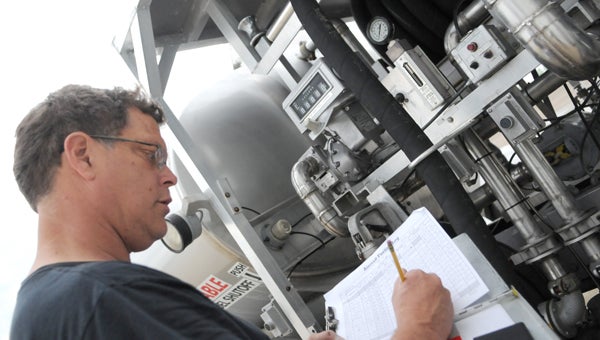Craig Field’s Selma Air Center increases fuel sales
Published 9:39 pm Monday, April 7, 2014

Josh Bergeron | Times-Journal
Checking it twice: Selma Center’s Richard Cook check’s his aircraft fueling log Monday at Craig Field. Selma Air Center, which runs Craig’s fixed base operations office has upped its fuel sales totals in the past year, meaning more flights coming into the airport.
During its Air Force days, Craig Field buzzed with activity. Airplanes took off and landed frequently as Craig served as a training center for young pilots.
Now, renamed Craig Field Airport and Industrial Complex, its not quite as busy, but traffic may be picking back up.
About every two weeks, the base sells 8,000 gallons of gasoline for planes taking off and landing at Craig Field, which still maintains an 8,000-foot runway. Current sales show a marked increase over two years ago, when Craig Field’s Selma Air Center sold the same amount of gas every two months, according to fixed base operations manager Richard Cook.
“More people are coming in and are buying more fuel than normally,” Cook said. “We try to be customer oriented, so the pilots come back. Because of the increase in fuel sales, we have been able to hire additional staff.”
Most piston-operated planes purchase 20 to 20 gallons when filling up, according to Cook Some planes purchase significantly more. Cook said a plane carrying family members of Boston Red Sox pitcher Jake Peavy purchased 600 gallons at from the Selma Air Center last year.
One of the primary reasons behind the increase, Cook says, is a government contract Selma Air Center secured in late 2012, when they were landings were fewer in number. The contract essentially allows pilots to use military fuel cards, according to Cook.
He says most of the increase in traffic comes from Fort Rucker, located between Dothan and Troy, but civilian takeoffs and landings have seen a small uptick as well. Increases in profits aren’t huge, but Craig Field director Menzo Driskell says the increase in traffic will lead to a higher priority on the Federal Aviation Administration’s funding list and, in turn, more improvements.
“The more we pump, the more we get out of it,” Driskell said. “Selling more fuel means more operations, or takeoffs and landings.”
When pilots land, two buildings sit adjacent to the runway for their use — a terminal building, with places to relax, and the fixed base operations building, with a flat-screen TV, dining area and internet access. Cook said Craig Field continues to increase its amenities in an effort to keep luring pilots back.
“Craig Field has invested a huge amount of money into the airport,” he said. “To me, it’s the biggest asset. It’s the front door to Selma.”
To keep up with demand, Cook and the Selma Air Center are planning to obtain a larger fuel truck. It’s current truck holds 3,000 gallons.
Regardless of increases, Driskell said Craig’s airport remains a vital asset.
“Hyundai suppliers have flown in here and can walks right across to their plant,” Driskell said. “It’s certainly an economic development tool.”





